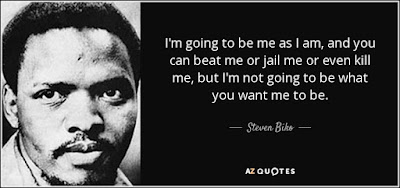I was inspired by a podcast called The 500 hosted by Los Angeles-based comedian Josh Adam Meyers. His goal, and mine, is to explore Rolling Stone's 2012 edition of The 500 Greatest Albums of All Time.
Album # 388
Album Title: The Indestructible Beat Of Soweto
Artist: Various Artists
Genre: Mbaqanga, Maskanda, Mqashiyo and Isicathamiya
Recorded: Various (Compiled on Earthworks Label)
Released: 1985 (Recorded 1981-1985)
My age at release: 20
How familiar was I with it before this week: Somewhat
Song I am putting on my Spotify: Qhule Manikiniki
Although it highlights the work of dozens of black, South African artists, this album was conceived and compiled by two white South African's living in Britain, Trevor Herman and Jumbo Vanrenen.
 |
| The Indestructible Beat Of Soweto - album cover |
The Indestructible Beat Of Soweto covers four styles of music (Mbaqanga, Maskanda, Mqashiyo and Isicathamiya) that were popular in the South Western Township of Johannesburg, hence the term SOWETO.
 |
| Soweto in north west South Africa |
When this record was released, this township was an impoverished, segregated region on the outskirts of the Johannesburg. At the time, South Africa was governed a form of institutionalized racial segregation in place since 1948, called Apartheid. Politically, socially and economically the country was controlled by the nation's minority white population. However, it in the crowded shanty-towns and matchbox-houses of Soweto that rhythmic, uptempo Zulu-inspired music flourished. For the inhabitants, it was a source of pride, escape, pleasure and discreet rebellion.  |
| Soweto - mid 1980s |
Mbaqanga (Mm-ba-kan-ga), the main style on the record, is a Zulu word for cornmeal porridge. Indeed, the sound is a delightfully infectious hodge-podge of percussion, jangly guitars, bright brass orchestration, singing and chanting with an African jazz influence. Words don't capture the wonderful sounds of the record. As the adage goes:
"Writing about music is like dancing about architecture."
It is a bright, energetic, effervescent sonic concoction. However, many of the songs have a sneaky, subversive message -- a euphonious rebellion for the disenfranchised masses.
I stumbled on the South African sound at a young age. In 1980, at 15, I moved to London, Ontario, from a rural farming community 200 kilometres away. I was enthralled by the facilities of a "big" city, with its public transportation and a downtown library that provided limitless inexpensive opportunity.
 |
| London's former Central Library |
The availability of books was only part of my joy; the library had stacks of records, including new releases, and readily accessible headset-listening booths.
That first autumn, I took the bus to the library from my new high school and spotted a record from musician Peter Gabriel. It was his latest release and, although untitled, is often dubbed Melt because of the image on the album cover depicting Gabriel's partially liquefying face. (See Below)
The final track was Biko, a song that (I would later learn) opens and closes with a chorus featuring two South African folk songs, Ngomhla Sibuyayo (When We Return) and Senzenai Na? (What Have We Done?). The haunting and ethereal sound, juxtaposed against Gabriel's modern instrumentation, was riveting.
The liner noted that this was anti-apartheid, protest song and eulogy for South African activist Bantu Steven Biko who died brutally in police custody in 1977. I had so many questions: What was apartheid?
Who was Biko?
Why did he die in police custody?
In a time before Google searches, gathering information about this event required deep-digging. However, I was in a library where the staff had come to know me by name and were eager to assist.
Slowly, I learned of the injustice that had been done to Biko and the atrocities that continued to be perpetrated on the black, South African majority. In a time before the phrase "woke" was coined I learned much about Biko and Apartheid.
Sometimes, my research came from scattered news reports or articles in magazines. However, it was the power of music bared the injustices of black Africa to the world, through artists such as Gabriel, Simple Minds, U2. They became part of the growing grassroots Boycott Apartheid Movement.
Guitarist Steven van Zandt brought the campaign into mainstream conversation. In 1985, he assembled a collection of famous musicians (Gabriel, Bono, Ringo Star, Keith Richards, Miles Davis and Bruce Springsteen) under the name Artists United Against Apartheid to release the song Sun City.  |
| Sun City record - released 1985 |
The gravitas of these individuals, many of whom are on The 500 multiple times, brought Apartheid into mainstream conversation in North America, and thus began a global movement that would end the rampant discrimination in 1994, culminating in the election of black hero Nelson Mandela as president.
The heart of this story is the Zulu-sound, and The Indestructible Beat of Soweto is a fantastic entry point for any new listener.








Islamic art is often characterized by recurrent motifs, such as the use of geometrical floral or vegetal designs in a repetition known as the arabesque. The arabesque in Islamic art is often used to symbolize the transcendent, indivisible and infinite nature of God. Islamic art isn't restricted to religious work, but includes all the artistic traditions in Muslim culture. Islamic art is a modern concept created by art historians in the 19th century. if you are looking a professional art designs, then please visit ISLAMIC ART DESIGN SHOP.Modern Islamic art
ReplyDelete